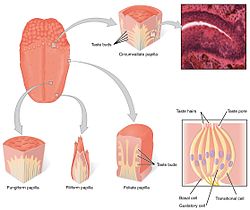Taste receptor
| Taste receptor | |
|---|---|

Taste receptors of the tongue are present in the taste buds of papillae.
|
|
|
Anatomical terminology
[]
|
A taste receptor is a type of receptor which facilitates the sensation of taste. When food or other substances enter the mouth, molecules interact with saliva and are bound to taste receptors in the oral cavity and other locations. Molecules which give a sensation of taste are considered "sapid".
Taste receptors are divided into two families:
Combinations of these receptors in dimers or other complexes contributes to different perceptions of taste.
Visual, olfactive, “sapictive” (the perception of tastes), trigeminal (hot, cool), mechanical, all contribute to the perception of taste. Of these, transient receptor potential cation channel subfamily V member 1 (TRPV1) vanilloid receptors are responsible for the perception of heat from some molecules such as capsaicin, and a CMR1 receptor is responsible for the perception of cold from molecules such as menthol, eucalyptol, and icilin.
The gustatory system consists of taste receptor cells in taste buds. Taste buds, in turn, are contained in structures called papillae. There are three types of papillae involved in taste: fungiform papillae, foliate papillae, and circumvallate papillae. (The fourth type - filiform papillae do not contain taste buds). Beyond the papillae, taste receptors are also in the palate and early parts of the digestive system like the larynx and upper esophagus. There are three cranial nerves that innervate the tongue; the vagus nerve, glossopharyngeal nerve, and the facial nerve. The glossopharyngeal nerve and the chorda tympani branch of the facial nerve innervate the TAS1R and TAS2R taste receptors.
...
Wikipedia
